- Annual Report 2013 >
- Financial Review and Data >
- Management's Discussion and Analysis
- Financial Position and Liquidity
- Dividend Policy
- Outlook for the Fiscal Year Ending March 31, 2014
- Konica Minolta Group Risks
The eurozone economy recorded negative growth affected by Europe's sovereign debt problem, and emerging economies, which had been leading global economic growth, were also sluggish. The U.S. economy is showing a trend of recovery as improvement in the employment environment and rising asset prices push up consumption. Meanwhile, economic conditions in Japan remained challenging for the manufacturing industry during the first half of the fiscal year as compounding factors such as the end of the cycle of disaster-related demand and the appreciation of the yen coincided with each other to flatten the economy. However, together with a change of government in Japan and a steep weakening of the yen, positive expectations about the economic outlook have been rising since the end of 2012.
Net Sales

In the fiscal year ended March 31, 2013, net sales rose ¥45.1 billion, or 5.9%, year on year to ¥813 billion as a result of the strengthened sales of the core products in each of the Company's business segments and promotion of M&A deals, in addition to the correction of the strong yen.
Operating Income

Despite the impact from delays to the planned cost reductions for some of the new products in the Business Technologies Business and the deterioration of market conditions in Europe, initiatives to increase sales and improve profits in the Industrial Business and the Healthcare Business contributed to achieving a gross profit margin of 46.2%, which remained flat year on year.
Selling, general and administrative (SG&A) expenses increased ¥19.9 billion year on year, accompanying the rise in sales that resulted from the promotion of strategies including M&As.
As a result of the above, operating income increased ¥0.3 billion, or 0.8%, year on year to ¥40.6 billion.
Income before Income Taxes and Minority Interests
Income before income taxes and minority interests increased ¥1.0 billion, or 3.1%, year on year to ¥33.8 billion as a result of ¥4.7 billion in loss on retirement of fixed assets and impairment losses relating to some production facilities and extraordinary losses, which included restructuring expenses.
Net Income

Net income decreased ¥5.2 billion, or 25.9%, year on year to ¥15.1 billion because of an increase in income taxes from the previous fiscal year.
Business Technologies Business
In the office field, sales of A3 color MFPs in the current fiscal year increased year on year helped by new products. The market for A3 monochrome MFPs is becoming increasingly mature, and sales declined in leading markets such as Europe. However, sales of A3 MFPs overall increased from the previous fiscal year.
In the production print field, sales volume of color production printing equipment increased in the United States and Japan amid a challenging market environment while monochrome production printing equipment rode the success of new products bizhub PRO 951, bizhub PRESS 1250 and bizhub PRESS 1052, which went on sale in the first half of the fiscal year, and sales volume increased year on year for both color and monochrome production printing equipment.
The Company has been aggressively promoting M&As in this segment to expand sales of output units, chiefly MFPs, and business solution services and to transform the scope of its business in the future.
In the office field, the Company boosted its capability to provide proposals for business process improvement to small and medium-sized corporate customers by acquiring IT service providers Serians S.A.S. based in France in June 2012 and Raber + Marcker GmbH based in Germany in December 2012 to strengthen its IT service capability, which is the key to delivering the business process improvement services it is promoting together with Optimized Print Services (OPS). The Company made five similar acquisitions in the United States (effective during the current fiscal year). The number of customers also increased in the area of sales to major global accounts. For example, the Company concluded a global agreement with a major European energy company.
In the production print field, the Company acquired FedEx Kinko’s Japan Co., Ltd., Japan's leading print on demand services company, in May 2012 and South Korea's FedEx Kinko's Korea Ltd. in January 2013 to strengthen marketing, service and solution proposal capabilities in the corporate in-house printing market. In Europe, the Company acquired U.K.-based Charterhouse PM Limited, a major print management services company specializing in material and cost optimization for production of its clients' printing needs and marketing planning with business in 18 European countries.
As a result, Business Technologies Business segment sales increased 6.2% year on year to ¥581.6 billion, and segment profit declined 19.8% to ¥31.6 billion. Sales increased year on year, helped by such factors as increased sales volume for new color MFPs products and production printing equipment and the effect of M&As. Profit in the segment declined, affected by the delay of the planned cost reductions for new products and the deterioration in market conditions in Europe.
Industrial Business
In the display materials field, sales of thin plain TAC films, a strong Group product, including 40μm TAC film, VA-TAC film for large screen TVs and 60μm TAC film, remained favorable, and sales volume for these products increased year on year. Moreover, the Company led the industry in commencing mass production of 25μm ultra-thin TAC film for the mobile phone market in November 2012, further boosting competitiveness in thin plain TAC film products.
In the optical products field, sales of glass substrates for hard disk drives (HDDs) and pickup lenses for optical disks were poor, strongly affected by the deterioration in market conditions, but the Company’s products were increasingly used in digital cinema projector lenses, interchangeable lenses for digital SLR cameras and zoom lens units for compact digital cameras. Moreover, the Company commenced shipments of mobile phone lens units for smartphones at the beginning of 2012, and sales volume of all products increased year on year.
In the measuring instruments field, the Company won major orders for light-source color measuring instruments, including the CL-200A chroma meter used in quality management of displays and LED illumination modules for smartphones and other applications during the manufacturing process and the CA-310 display color analyzer, and sales volume increased year on year. In November 2012, the Company acquired Germany-based Instrument Systems GmbH, which holds a large market share especially in high-end products, to strengthen competitiveness in the light-source color measurement field.
As a result, Industrial Business segment sales amounted to ¥146.7 billion, and segment profit stood at ¥23.6 billion. Sales volume increased for the segment’s main products overall, with the exception of some products in fields such as the optical products field. Both segment sales and profit increased.
Healthcare Business
In the Healthcare Business, the Company worked to expand sales of digital X-ray diagnostic systems to medical facilities in Japan and overseas. The AeroDR, a cassette-style digital X-ray system featuring a proprietary high-image quality scintillator developed and manufactured by the Company is compact and the world's lightest system while delivering lower exposure and high image quality. Sales for applications such as regular X-ray equipment and hospital rounds are expanding further, offsetting the decline in sales of film products chiefly in developed countries.
As a result, Healthcare Business segment sales amounted to ¥72.7 billion, down 0.4% year on year, and segment profit increased substantially from ¥90 million in the previous fiscal year to ¥3.3 billion as a result of the increase in gross profit associated with rising sales of digital X-ray systems and initiatives to improve profitability.
Cash Flows from Operating Activities:
Net cash provided by operating activities was ¥66.4 billion, compared with ¥72.3 billion for the previous fiscal year. Income before income taxes and minority interests provided cash of ¥33.8 billion. Depreciation and amortization totaled ¥45.9 billion, and amortization of goodwill totaled ¥9.8 billion. Uses of cash included a decrease in working capital of ¥11.1 billion and income taxes paid of ¥13.5 billion.
Cash Flows from Investing Activities:

Net cash used in investing activities was ¥63.4 billion, compared with ¥42.7 billion for the previous fiscal year. Payment for acquisition of property, plant and equipment used cash of ¥31 billion. Principal investments included molds for new products in the Business Technologies Business and investment in new businesses and enhancing production efficiency in the Industrial Business. Other uses of cash included ¥23.1 billion for payment for acquisition of shares in subsidiaries and transfer of business associated with acquisitions in Japan, Europe, the United States and Asia to strengthen production print and IT service capabilities in the Business Technologies Business and acquisition of equity in subsidiaries in the Industrial Business.
As a result, free cash flow, calculated as the sum of cash flows from operating and investing activities, was ¥3.0 billion, compared with free cash flow of ¥29.6 billion for the previous fiscal year.
Cash Flows from Financing Activities
Net cash used in financing activities was ¥24.5 billion, compared with net cash provided of ¥26.3 billion in the previous fiscal year. Uses of cash included payment of ¥40 billion for the redemption of corporate bonds and cash dividends paid of ¥7.9 billion while a net increase in short-term and long-term loans payable provided cash of ¥24.9 billion.

Total capital expenditure for the year ended March 31, 2013 increased ¥4.4 billion, or 13.0%, year on year to ¥38.4 billion. By business segment, capital expenditure totaled ¥22.0 in the Business Technologies Business, ¥9.4 billion in the Industrial Business and ¥1.5 billion in the Healthcare Business. Principal capital expenditure for the fiscal year ended March 31, 2013 included investment in molds for new products in the Business Technologies Business, and investment to increase production capacity in the Optics Business. Depreciation decreased ¥3.3 billion, or 6.6%, year on year to ¥45.9 billion.
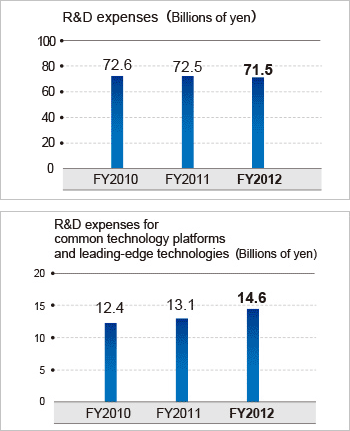
Research and development (R&D) costs decreased ¥0.9 billion, or 1.4%, year on year to ¥71.5 billion despite continued investment in future growth areas. By business segment, R&D costs were ¥39.3 billion, down 10.9% year on year, in the Business Technologies Business, ¥14.6 billion in the Industrial Business, and ¥2.8 billion, down 41.9% year on year, in the Healthcare Business. Basic research costs that were not included in the business units were ¥14.6 billion, up 11.4% year on year.
Assets
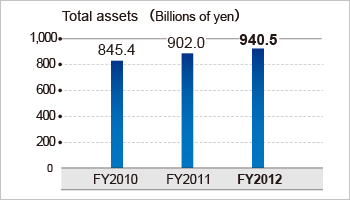
Current assets in the form of cash and cash equivalents at March 31, 2013 decreased ¥18.0 billion from a year earlier to ¥213.9 billion. Cash on hand and in banks increased ¥2.7 billion to ¥93.4 billion, short-term investment securities decreased ¥20.7 billion to ¥120.5 billion. Notes and accounts receivable – trade increased ¥19.8 billion to ¥194.0 billion. Inventories increased ¥7.3 billion to ¥112.4 billion.
Property, plant and equipment as of March 31, 2013 decreased ¥0.9 billion from a year earlier to ¥179.9 billion due to depreciation and capital expenditure in the Business Technologies Business. Intangible assets increased ¥23.5 billion from a year earlier to ¥110.9 billion due to increased goodwill as a result of business acquisitions in the Business Technologies Business and the Industrial Business. Investments and other assets as of March 31, 2013 increased ¥0.3 billion from a year earlier to ¥70.1 billion.
As a result of these factors, total assets at March 31, 2013 increased ¥38.5 billion, or 4.3%, from a year earlier to ¥940.5 billion.
Liabilities
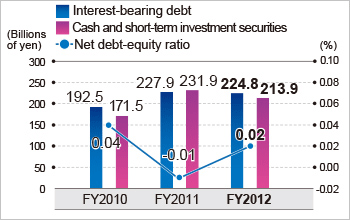
Notes and accounts payable – trade decreased ¥2.7 billion to ¥85.4 billion while interest-bearing debt (total of short-term and long-term debt and bonds) decreased ¥3.0 billion to ¥224.8 billion. However, total liabilities as of March 31, 2013 were ¥474.1 billion due to an increase in accrued expenses and accounts payables.
Net Assets
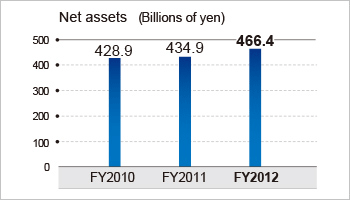
Accumulated other comprehensive income recorded an increase of ¥2.1 billion in unrealized gains on securities due to the effects of the stock market and an increase of ¥21.9 billion in foreign currency translation adjustments as a result of changes in foreign currency translation adjustments associated with the correction of the strong yen, mainly the U.S. dollar and the euro.
As a result of the above, net assets at March 31, 2013 increased ¥31.4 billion, or 7.2%, from a year earlier to ¥466.4 billion.
At March 31, 2013, the equity ratio increased 1.4% percentage points from a year earlier to 49.4%.
Basic Dividend Policy
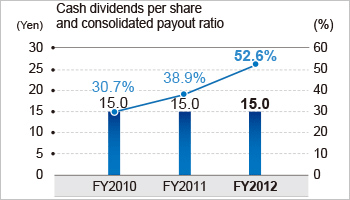
The Company considers distribution of earnings to shareholders a management priority under a basic policy of sustained distribution of earnings to shareholders after comprehensive consideration of factors including consolidated business results and strategic investment in growth areas. The Company's specific medium-to-long-term benchmark for dividends is a consolidated payout ratio of 25% or higher. The Company also considers factors such as financial position and share price in making decisions about share repurchases as another means of distributing earnings to shareholders.
Dividends for the Fiscal Year Ended March 31, 2013 and Planned Dividends for the Fiscal Year Ending March 31, 2014
Business results for the fiscal year ended March 31, 2013 recorded a decline in final profit despite increased sales, and the Company paid the scheduled year-end cash dividend of ¥7.50 per share. In conjunction with the interim cash dividend, cash dividends per share for the year ended March 31, 2013 totaled ¥15.00
For the fiscal year ending March 31, 2014, the Company assumes it will achieve its performance forecasts and plans to pay an interim and a year-end ordinary cash dividend per share of ¥7.50 each.
In August 2013, the Group will mark the tenth anniversary of the management integration between Konica and Minolta in 2003. In response to the constant support of shareholders, the Company will pay a commemorative cash dividend of ¥2.50 per share with the interim cash dividend for the fiscal year ending March 31, 2014 and therefore plans to pay a cash dividend of ¥10.00 per share combined with the ordinary dividend of ¥7.50 per share. As a result, the Company plans to pay a total cash dividend of ¥17.50 per share for the fiscal year ending March 31, 2014.
Looking at the global economic conditions surrounding the Group, the outlook for the European economy remains uncertain due to its fiscal problems. We expect that a trend of recovery in personal consumption underpinned by better employment conditions and rising asset prices will push up the economy in the United States. Growth in emerging economies is expected to remain high in the ASEAN countries and some others although ongoing monitoring will be required for the Chinese economy, which showed signs of slowing down in the second half of 2012. A marked recovery in the Japanese economy is expected from the second half of 2013 with the correction of the strong yen and a recovery in personal consumption in anticipation of rising prices.
In demand forecasts for the Company’s principal markets, we expect that in the Business Technologies Business, demand for color MFPs will continue to expand in developed countries both in the office field and the production print field. Demand is also expected to increase in parallel with GDP growth in the emerging economies. In the Industrial Business, while demand associated with the growth of the small and medium LCD market, which includes tablets, a slowdown in growth in the television market and negative growth in the PC market are also forecast, and we expect moderate growth for total TAC film demand.
In the Healthcare Business, demand for cassette-style digital X-ray systems is expected to maintain a high growth rate, primarily in Japan, the Americas and Asia.
Considering the above circumstances, we have made the following forecasts for the fiscal year ending March 31, 2014.
| Performance Forecast for the Fiscal Year Ending March 31, 2014(As of May 10, 2013) | (Billions of yen) |
|---|---|
| Net sales | 9,000 |
| Operating income | 550 |
| Operating income ratio | 6.1% |
| Amortization of goodwill | 260 |
| Capital expenditure | 470 |
| Depreciation | 500 |
| Research and development costs | 760 |
| Free cash flow | 25 |
| CF from operating activities – CF from investing activities | 325 |
Cash dividends per share 17.50
We assume exchange rates of JPY93 to USD 1 and JPY 123 to EUR 1.
Business Risks
Of the business operations and accounting status described in the Group's Securities Report, the following risks could have a significant effect on the judgment of investors in the Group. Further, the forward-looking statements in the following section are the Group's judgments as of June 20, 2013.
Economic Risks
(1) Economic Trends in Primary Markets
The Group provides MFPs, production printing equipment, image input/output components, display materials, products and equipment for use in healthcare, and related services to customers worldwide. Economic conditions in national markets significantly affect sales and earnings in these businesses.
Ongoing risks of concern in the global economy include the protracted uncertainty about the economy in Europe, which is experiencing fiscal problems, a slowdown of growth in the Chinese economy and monetary policy revisions in leading countries. Recessions in national markets that cause customers to restrain investment, reduce operating expenses or reduce consumption could adversely affect the Group's results or finances in ways such as causing inventories to increase, reducing sales prices by increasing competition, or reducing sales volume.
(2) Changes in Exchange Rates
The Group ameliorates the impact of exchange rates by conducting hedging transactions centered on futures contracts for major currencies including the U.S. dollar and the euro. In addition, the impact of U.S.dollar-denominated procurement for the MFPs, printers and production printing equipment the Business Technologies Business produces in China is light because it is basically offset by sales and payables in regions where sales are denominated in U.S. dollars. However, fluctuations in euro exchange rates directly impact earnings. Generally, yen appreciation versus the U.S. dollar and euro negatively affects results, while yen depreciation versus these currencies positively affects results.
Industry and Business Activity Risks
(3) Competition in Technology Innovation
The ability to innovate faster than other companies is the primary source of competitive advantage in the Group's core businesses including MFPs, production printing equipment and other information equipment, TAC polarizing film for LCDs, and pickup lenses for optical disks, and in the Group's key areas for future development including organic electroluminescent (EL) lighting.
The Group continually takes on the challenge of innovative technology development and invests aggressively in R&D and facilities, but these efforts may not be timely enough. Moreover, competitors may develop similar or alternative technologies more quickly. Accurately determining new directions in technology innovation to meet customer needs is crucial, and failure to do so could reduce the Group's competitiveness in its core and new businesses.
(4) Operating Environment in the Equipment and Service Businesses
Solution and service needs are increasing in conjunction with rising demand for high-value-added products that are networked and multifunctional, including information equipment such as MFPs, printers and production printing equipment, and healthcare equipment. In addition, companies are strengthening their sales channels through acquisitions, reorganization and alliances with IT companies, particularly in the information equipment industry. Competition among manufacturers and distributors that respond to this trend is expected to further intensify competition within the industry.
The Group operates under a policy of being the genre leader in its Business Technologies Business, the Group's largest business and growth driver. The Group led the industry in concentrating resources to expand its office-use color MFP and production printing equipment businesses, thus establishing itself as the leading Group in European and North American markets. However, the Group cannot guarantee continued competitive advantage because technological innovation is rapid in this field and the importance of the solutions and services business is further increasing. Slower growth resulting from inability to maintain competitiveness in technology and sales channels in the Business Technologies Business could adversely affect the Group's results. Moreover, restrained corporate investment or cost reductions could cause installation of new MFPs to decrease, which could adversely affect the Group's results in the future.
(5) Operating Environment in the Industrial Business
The Industrial Business supplies components and materials for LCD televisions, DVD and HDD products, and other products in the digital home appliance market. Selling prices continue to trend downward due to intense competition among manufacturers in this market, which affects component and material suppliers such as the Group. At the same time, shorter product lifecycles require component and material manufacturers to sell mass-produced products in a short time. Rapid changes in supply and demand due to production adjustments caused by market competition could adversely affect the Group's results.
In addition, the Industrial Business's major customers are digital home appliance manufacturers. Rapid changes in demand or decreases in prices in addition to failure to respond sufficiently to the industry trends the Group identifies, such as global reorganization of the digital home appliance industry or next-generation products, could result in loss of customers and adversely affect the Group's results.
(6) Quality Problems
The Group has created a rigorous quality assurance system for Group companies and contract manufacturers in Japan and overseas, and provides customers with high-performance, reliable products and services. The Group could be responsible for compensation for damages that result if the Group should happen to provide defective products or services. Moreover, remedying such defects may result in significant expenses. In addition, media reports on such problems could adversely affect the Group's operations and image.
(7) Global Business Activities
The Group conducts a majority of its business outside Japan in North America, Europe and Asian countries. These global corporate activities entail the following risks:
・Exchange rate movements
・Political and economic uncertainties
・Unanticipated changes to legal, regulatory and tax codes
・Hiring and retaining outstanding employees
・Industrial infrastructure vulnerabilities
The Group considers it is vital to expand its business in overseas markets, and inability to respond adequately to these characteristic risks of global business activities could adversely affect the Group’s results and growth strategy.
The Group is concentrating on expanding production in China to enhance cost competitiveness in its core Business Technologies Business and Industrial Business. The Business Technologies Business has established two production bases in Dongguan and Wuxi that produce and ship nearly all of the MFPs, printers and production printing equipment it sells globally. In addition, the Industrial Business has established production bases in Dalian and Shanghai that produce image input/output components and other products.
China continues to develop economically and make progress in areas such as improving its legal system and upgrading infrastructure. However, legal changes, labor policy difficulties, increased personnel expenses, appreciation of the Chinese yuan, changes in import and export regulations and the tax code, and other developments that are difficult to anticipate may occur. Inability of the Group to effectively handle the risks inherent in having a large percentage of the manufacturing activities of its core businesses in China could adversely affect the Group's results and growth strategies.
(8) Securing Human Resources
Skilled human resources are the source of growth for the Group. The Group increasingly requires outstanding engineers and highly skilled workers who can further develop core technologies in businesses including optics, materials, precision processing, and imaging in order to maintain the Group's high level of competitiveness in the future. In addition, prevailing over competitors as digitalization and networking advance requires the Group to secure outstanding engineers and systems engineers to quickly strengthen information and communication technologies such as software and control technologies. Beyond technology, the Group has a growing need for personnel in areas such as marketing, sales and service to create new sources of earnings from businesses including solutions and services. However, there is a large demand for such human resources, and competition between companies to secure human resources is intense. Inability of the Group to secure and retain skilled human resources could adversely affect the execution of the Group’s growth strategies.
(9) Alliances with Other Companies
The Group is enhancing competitiveness and efficiency by collaborating with other companies through means including technology and business alliances and joint ventures.
In the Business Technologies Business, the Group has aggressively promoted M&As to expand sales of output units, chiefly MFPs, and business solution services and transform the nature of its business in the future. In the office field, the Group made two acquisitions in Europe and five in the United States to strengthen its IT service capability, which is the key to delivering the business process improvement services it is promoting together with Optimized Print Services (OPS). In the production print business, the Group made a total of three acquisitions in Japan, Europe and Asia to further strengthen competitiveness in the corporate in-house printing field and to expand the scope of its business into the entire production print field, which includes the commercial market. The Group will continue to forge alliances with other companies and make acquisitions as a strategic growth option.
Mutually supplementing technology and expertise under agreements with other companies strongly helps the Group to provide new products and services that respond to customer needs in a timely manner. Inability to continue collaborative relationships for operating, financial or other reasons or inability to achieve the expected outcomes of such relationships could adversely affect the Group's growth strategy.
(10) Rising Raw Material Prices
Rising prices for metal products including silver, steel and aluminum; petrochemical products made from crude oil; scarce natural resources such as rare earth minerals; and other raw materials that the Group uses in its production activities could affect the Group's results.
The Group works to reduce costs and raise the prices of its products as raw material prices rise, but cannot guarantee that it will be able to completely compensate higher raw material prices. Raising product selling prices may also reduce sales volume.
(11) Raw Material and Resource Procurement
The Group procures specified products, components and materials from external suppliers. Unanticipated contingencies among these suppliers could adversely affect the Group's production and supply capabilities.
Legal and Litigation Risk
(12) Intellectual Property
The Group accumulates differentiating technologies and expertise in the course of product development to ensure the competitiveness of its businesses, and works to protect these intellectual property rights. However, legal constraints in certain regional areas may preclude full protection of intellectual property and render the Group unable to prevent third parties from manufacturing and selling products that employ the Group's intellectual property.
Furthermore, the Group tries to avoid infringing on the rights of other companies in developing products. However, differences of opinion or other factors may result in the assumption that the Group is infringing on the rights of other companies, which could render the Group unable to use important technologies or make the Group responsible for paying significant monetary compensation.
Furthermore, in the future the Group may be prohibited from using intellectual property rights it currently licenses from third parties, or such use may be subject to unreasonable conditions.
(13) Healthcare Systems
The Group's Healthcare Business is subject to the ongoing influence of the healthcare systems and approval processes of the countries in which it operates. Factors including healthcare system reform could result in significant and unanticipated changes to healthcare administration policy. Inability to respond quickly to changes in the operating environment in the Healthcare Business could adversely affect the Group's results.
(14) Environmental Regulations
The Group is subject to various environmental laws and regulations governing issues including air pollution, water pollution, removal of hazardous substances, waste treatment, product recycling, and soil and groundwater contamination. The Group may incur expenses and financial liabilities for environmental obligations associated with past and present manufacturing activities. In addition, the Group may incur additional compliance obligations and expenses if environmental laws and regulations become more rigorous in the future, which could adversely affect the Group's results.
(15) Information Leaks
The Group obtains personal and confidential information on customers and business partners in the course of operations. The Group has a system for managing this information and implements measures including employee training, but unexpected contingencies could cause this information to leak externally. This could expose the Group to liability for damages to injured parties, and could adversely affect the Group's credibility and image.
In addition, leakage of the Group's confidential information related to matters including technology, contracts and personnel could adversely affect the Group's results.
Disasters and Other Risks
(16) Disasters
The Group has bases worldwide involved in activities including R&D, procurement, production and sales and operates globally. Disasters including earthquakes, fires, typhoons or flooding; pandemics similar to the outbreak of H1N1 influenza; or war, acts of terrorism or computer viruses could damage the Group's facilities, temporarily halt operations or delay production and shipments. Such disasters could also disrupt or restrict use of essential utilities such as electricity, gas and water; cause supply shortages of components and raw materials by damaging suppliers; halt distribution; or disrupt markets. Such circumstances could reduce net sales below initial plans, incur significant expenses to restore damaged facilities, or have other outcomes that could adversely affect the Group's results.
(17) Impairment of Long-Lived Assets
Effective the fiscal year ended March 31, 2006, the Group adopted accounting standards for impairment of long-lived assets including property, plant, equipment and goodwill. The Group periodically evaluates the carrying value of long-lived assets on the consolidated balance sheets to determine if their residual value is recoverable with expected future cash flows from the asset. The Group recognizes impairment when the asset no longer generates sufficient cash flow because its operating profitability has decreased due to competition or other reasons, which could adversely affect the Group's results.














